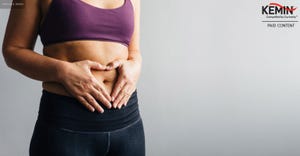In part one of this two-part series, Robin Koon offers insight on the ‘beauty from within’ concept and discusses important ingredients for skin health.
September 16, 2015

Despite the impossible standard of beauty coming from the world around us, the world does have a saying: “beauty is only skin deep." The world is also constantly telling us that "real beauty comes from within." Admittedly, there is a vast difference between looking beautiful and feeling beautiful.
It isn't just beauty that many of us desire and strive for, it's natural beauty, which is a sign of good health—a youthful and beautiful appearance. We see this as skin that is clear, radiant and healthy-looking; hair that is lustrous, shiny, silky and vibrant; and nails that are strong.
The premise for beauty from within has several main points regarding causation:
1. Deficiencies: A deficiency of any essential nutrient, including vitamins, minerals, fat or protein, can cause impairment within the body, especially in the making of new cells. Therefore, a healthy diet is crucial for hair, skin and nail health, as well as overall appearance.
2. Aging: The effects of aging occur with cells’ continuous bombardment by highly reactive oxygen species (ROS) molecules called free radicals. These free radicals are produced as a normal by-product of cellular metabolism (or reaction to the environment, such as sun and pollution). The body has developed a defense system against these free radicals, known as antioxidants. Normally, the body’s own production of antioxidants is able to keep up with the generation of free radicals, keeping the system in balance. This is the basis of the free radical theory of aging, which states that aging is a result of oxidative stress that occurs when there is an excess amount of free radicals. This cumulates over time, leading to aging.
3. Environment: The effect of environmental exposure can directly affect the outer surface of the body. This can be from many sources: environmental conditions (weather, temperatures, sun, etc.) and exposure to various forms of pollution (air, chemicals, smoking, etc.).
4. Genetics: The effect of our genes also play a role. Genes determine and control the physical, mental, intellectual, emotional, biological and physiological behavior of an individual. The genetic code is a blueprint of the body’s composition and interactions with various internal and external environmental factors.
Using a dietary approach to combat or improve exterior beauty by ingesting nutrients now has a term: nutricosmetics. This term describes the “beauty from within" concept, which is using nutritional intake to improve skin, hair and nails.
The first sign of aging is usually reflected on the skin in the form of wrinkles and furrows. The layer of skin known as the dermis can lose from 20 to 80 percent of its thickness during the aging process. As we age, the collagen/elastin matrix (or structure) in skin loses its ability to hold its shape, so the skin begins to sag. This is due to decreased collagen/elastin and hyaluronic acid production. As the matrix of collagen/elastin and hyaluronic acid shrinks, the skin becomes thinner and less elastic.
Collagen makes up about 30 percent of the total protein in the human body. Collagen has very resilient tensile strength that mostly resides in connective tissues in the skin and joints, such as cartilage, skin dermis, bones, tendons, ligaments and blood vessels. So far, science has identified and described 28 types of collagen. More than 90 percent of the collagen protein in the body is type I. Type I and type III are the types found in the skin. As we age, collagen production naturally slows and the overall amount depletes, which can result in undesirable wrinkles in the skin and painful stiffness in the joints. Taking type I and III collagen supplements can aid in giving the body the raw materials it needs to rebuild collagen. There are some newer hydrolyzed collagens I and III, and collagen peptides (e.g., brand name Verisol™ by Gelita) that are showing great help in increasing collagen levels in the skin.
Elastin is a highly elastic protein in connective tissue, and it allows many tissues in the body to resume their shape after stretching or contracting, such as skin (helps to return to its original position when it is pinched or stretched), and for other body areas that require flexibility (e.g., arteries, lungs, bladder, tendons, ligaments, etc.). Elastin does not get replenished by the body (not normally made/synthesized any more) after age 20. Pro-inflammatory lifestyle habits have a destructive effect upon elastin. A few dermatological studies have indicated that zinc supplementation may help restore some of the elastin.
For more on natural ingredients to promote skin health, as well as ingredients for healthy hair and nails, be sure to check out part two of this “beauty from within" series, which will be available on the beauty blog next week.
Robin C. Koon is executive vice president at Best Formulations with more than 35 years of pharmaceutical experience in clinical pharmacy practice (also a retail drug chain executive overseeing operations, and in managed-care), and in nutraceutical/pharmaceutical manufacturing.
About the Author(s)
You May Also Like




.png?width=800&auto=webp&quality=80&disable=upscale)